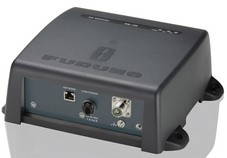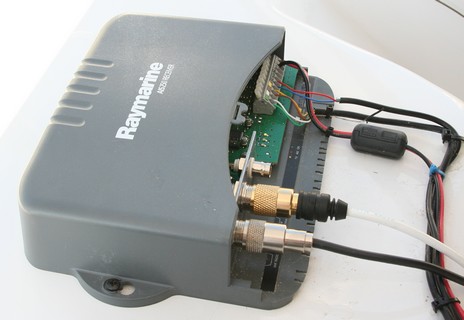AIS Miami, good times
 Yeah, man, that’s an Ethernet port on the new Furuno FA30 AIS receiver, meaning that it can plug right into a NavNet vx2 network. It also has standard NMEA 0183 38.4k AIS output, and comes with a PC AIS plotting program able to use the Ethernet feed, so it could be set up in many ways. The FA30 is a true dual channel receiver and will retail for “under $1,000.” It’s slightly bulky at about 10 x 8.5 x 3.5 inches, but that same box will house a Furuno Class B AIS that they’re planning to introduce eventually.
Yeah, man, that’s an Ethernet port on the new Furuno FA30 AIS receiver, meaning that it can plug right into a NavNet vx2 network. It also has standard NMEA 0183 38.4k AIS output, and comes with a PC AIS plotting program able to use the Ethernet feed, so it could be set up in many ways. The FA30 is a true dual channel receiver and will retail for “under $1,000.” It’s slightly bulky at about 10 x 8.5 x 3.5 inches, but that same box will house a Furuno Class B AIS that they’re planning to introduce eventually.
I’m a bit disappointed that Raymarine’s AIS250 is only a one-channel-at-a-time receiver, sporting a pretty stiff $1,120 MSRP too, but it does pack a lot of features under the hood. For one thing, it’s got a built in antenna splitter, allowing just one stick to feed AIS, FM, and VHF sets (preferably your standby set). It also has a built-in multiplexer offering two inputs and two outputs, all able to talk at either 4,800 or 38,400 baud as needed. This can solve lots of installation issues, particularly with single-NMEA-port C– and E-Series machines. Note that ShipModul has a special multiplexer for doing AIS with Ray C/E, as does Brookhouse (informative PDF here), and SeaCas is offering a dual channel receiver/multiplexer bundle.














I don’t suppose you managed to see what was inside those boxes, did you?
Sounds like Furuno is leaps and bounds above the Raymarine offering. Don’t suppose that FA30 will plug ethernet into my Raymarine ethernet Hub and E-Series chartplotters?
Has anyone come across this AIS problem before. I’ve heard of it now on two Raymarine E80’s with two different AIS receivers (one was NASA the other I don’t know but it was out of Germany)?
It seems when there are a lot of targets (40 or 50) a buffer somewhere overflows and the Raymarine E series shuts down.
If any of them shut down at less than 500 targets then stay away from the Singapore Straits. I had the SOB program max out at 300 targets then slowly reduce the number to 17 while surrounded by ships. In this case it was a problem with the SOB software which required restarting the program to clear the buffer which, once full, would only delete targets as they disappeared and would not replace them with new targets. I doubt that very many AIS programmers have experienced such large numbers of targets in one locale.
I heard that this is a known issue with the Raymarine E series plotters & that Raymarine are looking at a software fix. I understand that the plotter actually re-sets itself when this problem occurs…
Interestingly Raymarine’s new multiplexer (E55059)is made by Shipmodul, it has 4-In and 2-Out but it is 4800 only. No input for 38,400.
I guess they want to sell you their own AIS unit with built in multiplexer.
Ben, do you have any pull with Raymarine … to suggest to them they should shelve this AIS unit and start over. It’s not to late to kill it before they sell any, and come out with a replacement product. Better to have something out late, then something lame like this.
Easy with the presumptions, b393capt! I just wrote that “I�m a bit disappointed”, and that’s all I meant. My concerns about one-channel-at-a-time receivers mostly involve plotting Class B targets, and we haven’t even experienced those yet. So I may be overly concerned. I certainly don’t think Raymarine’s product is “lame”, let alone that they should pull it. The AIS250 appears to be very easy to install (and its street price may turn out to be much less than the MSRP). By the way, while I don’t know about “pull”, I do know that some Raymarine decision makers read Panbo!
I’m looking for an AIS solution for my boat and find this a little confusing. I currently have a Shipmodul multiplexer, a Ray E80, autopilot and computer running GPSnavX. The computer and the E80 will have separate GPS sensors. What am I getting with the Raymarine unit for $1100 that I don’t get with say the SR161 or Easy AIS with a splitter for about $300? I think I’m going with the SR161 but I thought I’d ask if I’m really missing out on something.
richard.
Ben, my Raymarine kill it / start over comment relates to my dissapointment of this device. I really would have liked it to have an ethernet connection, like the Raymarine Sirius receiver I purchased over the summer, as well as true dual channel reception. Then, I would get really excited if it introduced the “safe pass” method of displaying AIS contacts I read about on your site, so my crew dosn’t need to do vector math in their head to understand an environment rich in contacts.
Semi-related, it would also be real helpful if my E-80’s (while leaving my boat in the center of the screen) didn’t display contacts in relative direction and speed, while the AIS displays contacts in true direction and speed.
Why kill it … because I think I am the kind of customer they hope to sell it too, and I just don’t find it appealing at all.
Wonder if I could get myself invited into a product management briefing in the future, so I can voice these things before they release the product.
I have just installed the AIS250 on my E120. AT this time the unit is not displaying any info. I will contact Raymarine tomorrow for help!
I was told the unit would be delayed two months to fix a problem with tracking contacts, two days later the unit arrived at West Marine.
Best
Duncan
Duncan, did you change the baud rate for the NMEA port on your E120? This is pretty easy to overlook, in my experience. Go to Menu>Setup>System Integration (this is from memory, forgive me if it’s not these precise words on your screen), and then find the NMEA port item on the list and change its data rate to 38400/AIS.
I was quiet disapointed about raymarine AIS250.
I had problems with two AIS250. One cause the E series display shut down by itself. One will lost connection sudently.
Gentlemen,
Let’s face it, an AIS receiver is just that and you would do very well with the SR-161 single channel or SR-162 dual channel at half (or less) the price of a Raymarine AIS receiver. Put up a separate 3db short antenna just for AIS to avoid using a lossy antenna multiplexer (still get about 12nm range), and look at the forums for ways to avoid using a nmea 0183 multiplexer. One scheme feeds your 4.8k gps nmea 0183 into the milltech receiver which will accept it and merge it with the AIS output at 38.4K. I have been happy to provide Raymarine with thousands of my hard earned dollars, when I believed they were providing a useful product — and they have many useful products. The AIS receiver just isn’t one of them.
Bill
p.s. anyone want a used Raymarine RC400? (kidding)
does anybody know if the 250 ais will work on other brand chat plotters ….specifically the navman/northstar M121 cheers roja
wb3v: It ought to. It’s just NMEA 0183, power, and antenna connections…all pretty generic. But be sure to read more of Ben’s coverage of AIS units before you buy this Raymarine unit. A lot of minor innovations and price momentum (downward) have occurred in the past two years.
And one thing you MUST ensure, which I can’t answer: will your Navman/Northstar M121 handle the high-speed NMEA 0183 traffic? Some older units may not at all, or may require a firmware upgrade to do so. Make sure you know this before you make any AIS purchase decisions.